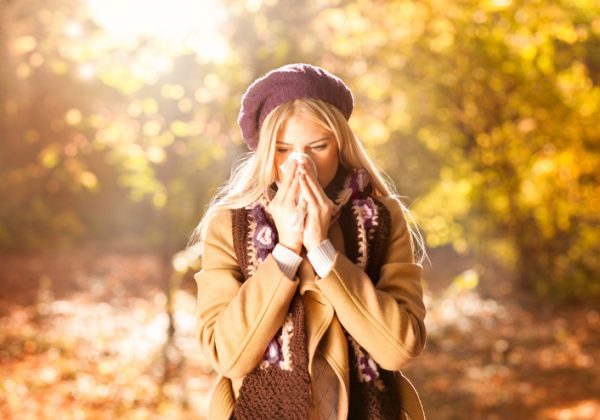
Check out our latest products
While most people tend to think of spring as peak allergy season, the reality is that millions of people suffer from allergies all year long, and the Fall season can be particularly bothersome for allergy sufferers.
Hay fever—which actually has nothing to do with hay or fevers—is a general term used to describe the symptoms of late summer and fall allergies. The biggest culprits of hay fever are pollen and ragweed.
According to the American College of Allergy, Asthma, and Immunology (ACAAI), ragweed starts to release pollen in mid-August, when the days are still warm and the nights start to get cooler. It can last well into September and October, typically continuing to wreak havoc until the first hard freeze, depending on where you live. It grows wild almost everywhere, especially on the East Coast and in the Midwest. Ragweed pollen is really light, so it spreads far and wide, and even if ragweed doesn’t grow where you live, ragweed pollen can travel for hundreds of miles in the wind!
Autumn leaves can also trigger allergic reactions for millions of people. While most homeowners find it difficult to keep up with all those pesky leaves, for allergy sufferers, raking leaves presents even greater challenges. It can agitate pollen and mold, releasing it into the air, causing allergy and asthma symptoms to spike.
Speaking of mold, it’s yet another fall allergy trigger. While we know that mold can grow in damp areas in the house, mold spores also love wet spots outside. Piles of damp leaves and decaying plants are ideal breeding grounds for mold.
Indoor Allergens
While the great outdoors is the source of most seasonal allergens (which also make their way inside on clothes, shoes, hair, and more), our homes harbor all sorts of indoor allergens, with many causing chronic suffering and asthma, especially for those who are more susceptible to respiratory issues, like young children and the elderly, or those with auto-immune disorders.
With simple everyday living, all sorts of unseen contaminants and air pollutants are generated, like dirt, dust, pet dander, cigarette smoke, and even chemicals. Those pesky dust mites and other pollutants get stirred up in your indoor air anytime your HVAC system is running, whether air conditioning or heat. That’s because your HVAC system pulls in all those contaminants and pollutants, and then recirculates the air throughout your home an average of five to seven times per day!
Then there’s mold, which is perhaps the most bothersome allergen of all. Mold and mildew can lurk all around your home, and if undetected or ignored, mold growth can turn into a serious health issue for everyone living under its roof.
Just like seasonal outdoor allergies, indoor allergens trigger sneezing, wheezing, runny noses, and more.
Tips for Dealing with Allergens in the Home
While there is no cure for allergies, many of the appliances you may already have around the house—namely a room air cleaner, vacuum, and clothes washer—can help reduce indoor air pollutants. Following are our best tips for dealing with indoor allergens:
- Invest in a room air cleaner. Portable room air cleaners, also called air purifiers, represent the quickest, most accessible option for improving indoor air quality in the home. Air cleaners can filter out harmful particulates such as tobacco smoke, dust, and pollen, making the air your family breathes cleaner and healthier. When you’re ready to purchase an air cleaner, always look for the AHAM Verifide® mark (learn more about AHAM Verifide below).
- Wash your bed linens and pillowcases in hot water and detergent to reduce allergens; dry them in a hot dryer cycle to kill dust mites. Keep pets out of the bedroom to reduce pet dander in your bedding. Use dust mite-proof covers for pillows, comforters, duvets, mattresses, and box springs.
- Vacuum frequently. Vacuuming helps keep allergens low, but keep in mind that poor quality vacuums can put dust back into the air. Look for certified asthma- and allergy-friendly vacuums.
- Prevent pollen from getting inside by keeping windows and doors closed. Use air conditioning in warm weather to control dust mites and reduce humidity. Change filters often.
- Take a shower, wash your hair, and change your clothes after you’ve been working or playing outdoors. Ask everyone who enters your home to leave their shoes at the door.
- Control dust mites by keeping surfaces in your home clean and uncluttered.
According to the Asthma and Allergy Foundation of America (AAFA), allergies are one of the most common chronic diseases, with more than 100 million Americans suffering from various types of allergies each year.
About AHAM Verifide
When you’re ready to purchase an air cleaner, always look for the AHAM Verifide® mark. Room air cleaners certified through the AHAM Verifide program have been rigorously tested by an independent laboratory to ensure the product will perform to the manufacturer’s product claims for the suggested room size. AHAM’s standard for measuring an air cleaner’s efficacy is called the Clean Air Delivery Rate (CADR). CADR indicates the volume of filtered air an air cleaner delivers, with separate scores for tobacco smoke, pollen and dust. The higher the CADR number for each pollutant, the faster the unit filters the air. The AHAM Verifide mark can be found on product packaging.
To find AHAM Verifide® room air cleaners, use AHAM’s online searchable directory to locate the model that’s right for you.
Find a Certified Room Air Cleaner Here
Subscribe to the AHAM Consumer Blog














